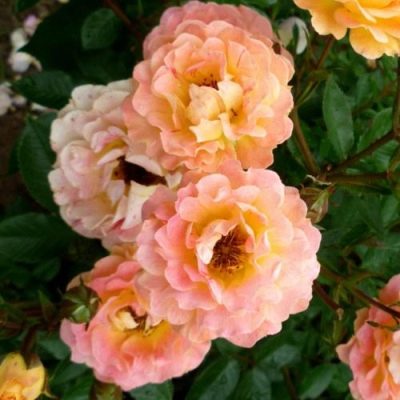
- Authors: Interplant
- Name synonyms: Bessy
- Breeding year: 1998
- Group: ground cover
- The main color of the flower: orange
- Flower size: small
- Diameter, cm: 4-5
- Flower type by number of petals: medium terry
- Description of the bush: very compact
- Bush height, cm: 40-60
The pink Bessie variety was bred in the Netherlands back in 1998. Also called Bessy. The variety belongs to the ground cover group. An ornamental plant is used for cutting.
Description of the variety
Rose Bessie is a very compact bush, which reaches an average height of 40-60 cm and a width of 70 cm. The color of the leaf plates is usually dark green.
The flowers have a beautiful golden apricot color. Their main color is orange. The shape is spherical. On average, the diameter of each flower is 4-5 centimeters. By the number of petals, the flower is considered moderately double. The buds are collected in separate inflorescences. One stem contains 4-5 flowers. They have a strong, pleasant aroma.
This variety is ideal for landscaping various areas, including large park areas. It is suitable for both single and group decorative plantings. Often Bessie is also used as a curb plant.
Advantages and disadvantages
This rose has many important benefits. So, it can boast of increased resistance to frost, as well as to various pests and diseases, including black spot, powdery mildew. In addition, among the advantages should be highlighted the beautiful decorative appearance of the flower.
This variety has practically no drawbacks. It is only worth noting that the flower can burn out strongly in the sun.
Flowering features
Rose Bessie blooms from June to October. Her flowering is quite abundant. This species is considered to be continuously flowering.
Landing
The planting of such an ornamental plant should be carried out from March to May and from August to October. In this case, it is necessary to carefully prepare the soil before planting, since the ground cover rose will literally creep along the ground, which will greatly complicate its further weeding. All plant residues must be removed from the soil immediately.
Planting holes for such vegetation are recommended to be prepared in advance. Remember that their depth should be a couple of centimeters deeper in comparison with the length of the root system.
Growing and care
This plant is best grown either in full sun or partial shade. For him, fertile and breathable soils will be the best option.
Moreover, after planting, the rose will need watering (once every 7 days). They can be increased in dry and dry weather. It will also be necessary to make additional fertilizing, ready-made compositions for flowering plants will be the best option.
With the onset of stable frosts, Bessie will need to be covered with a special material. But remember that the flower still easily tolerates frosts down to -7 degrees. Before sheltering, the ground around the bushes must be earthed. Also, the variety will require mulching. The rose also needs pruning (sanitary and formative).
Diseases and pests
This variety is considered to be very resistant to both pests and diseases. It is extremely rare that a flower can be affected by black spot, in which small black spots form on the vegetation, gradually the foliage begins to dry out and fall off. Also, occasionally, the rose is affected by powdery mildew, in which shoots and foliage are damaged. With severe infection, damage can also be seen on young buds, blossoming flowers.To cure vegetation, it is better to immediately apply fungicides ("Fundazol"). To precisely prevent infection, you can treat the vegetation with solutions of potassium permanganate.
Sometimes harmful insects appear on the rose, including aphids, spider mites. Most often, they settle on plants due to improper care. To get rid of them, you should use insecticides ("Decis", "Fitoverm", "Inta-Vir").
Reproduction
Bessie's rose can be propagated by cuttings. With a vegetative propagation method, it will be possible to preserve the main varietal characteristics. Cuttings must be harvested from young and strong bushes after the first flowering.
Review overview
Gardeners spoke positively about Bessie roses. It was noted that this species is absolutely unpretentious to care for. The stems of the plant are very strong, it has continuous flowering. But at the same time, some noted that the flowers quickly fade under the influence of sunlight.































































